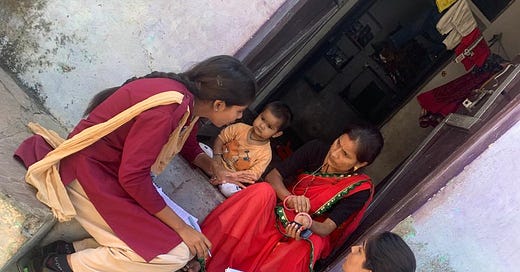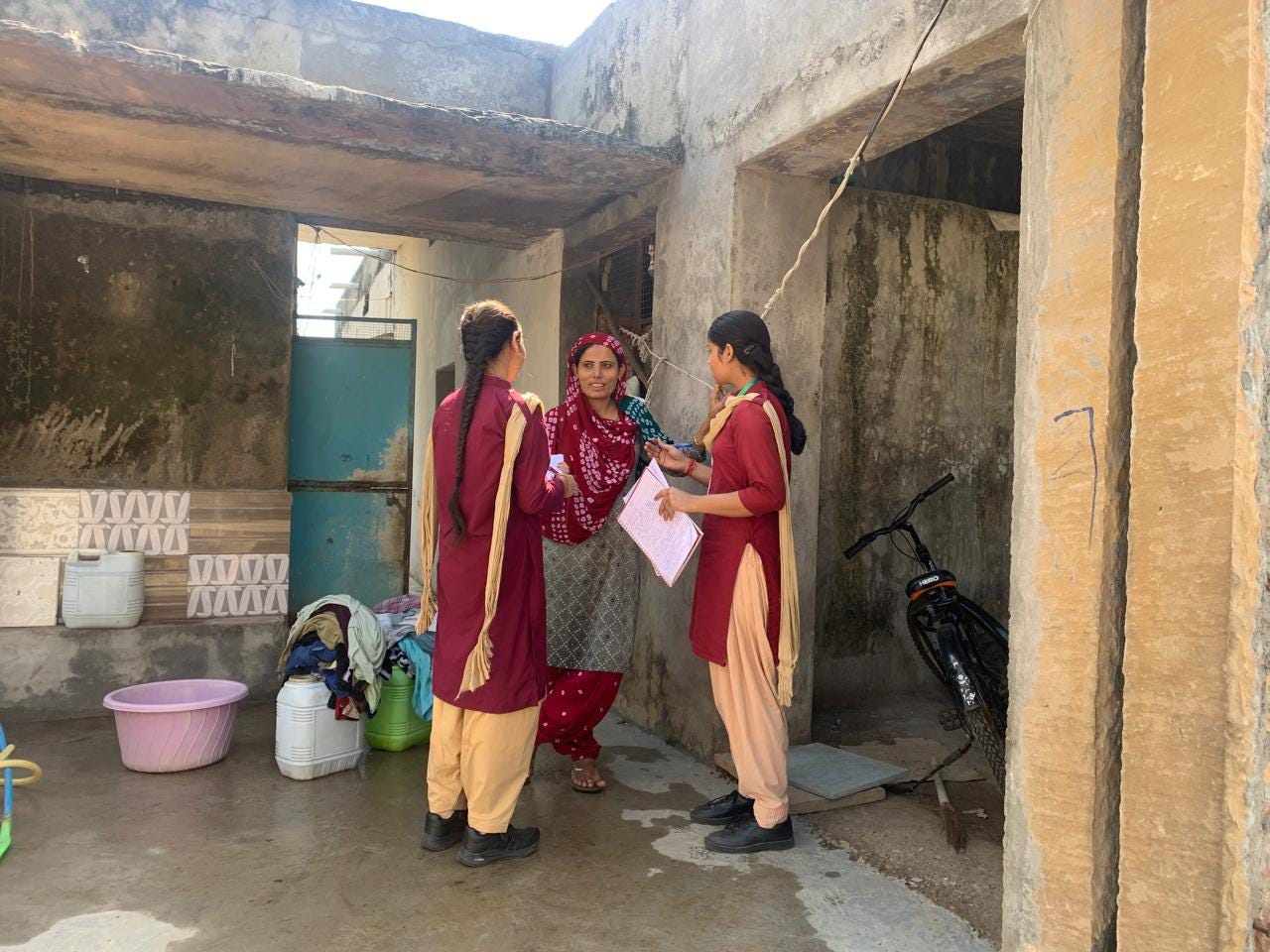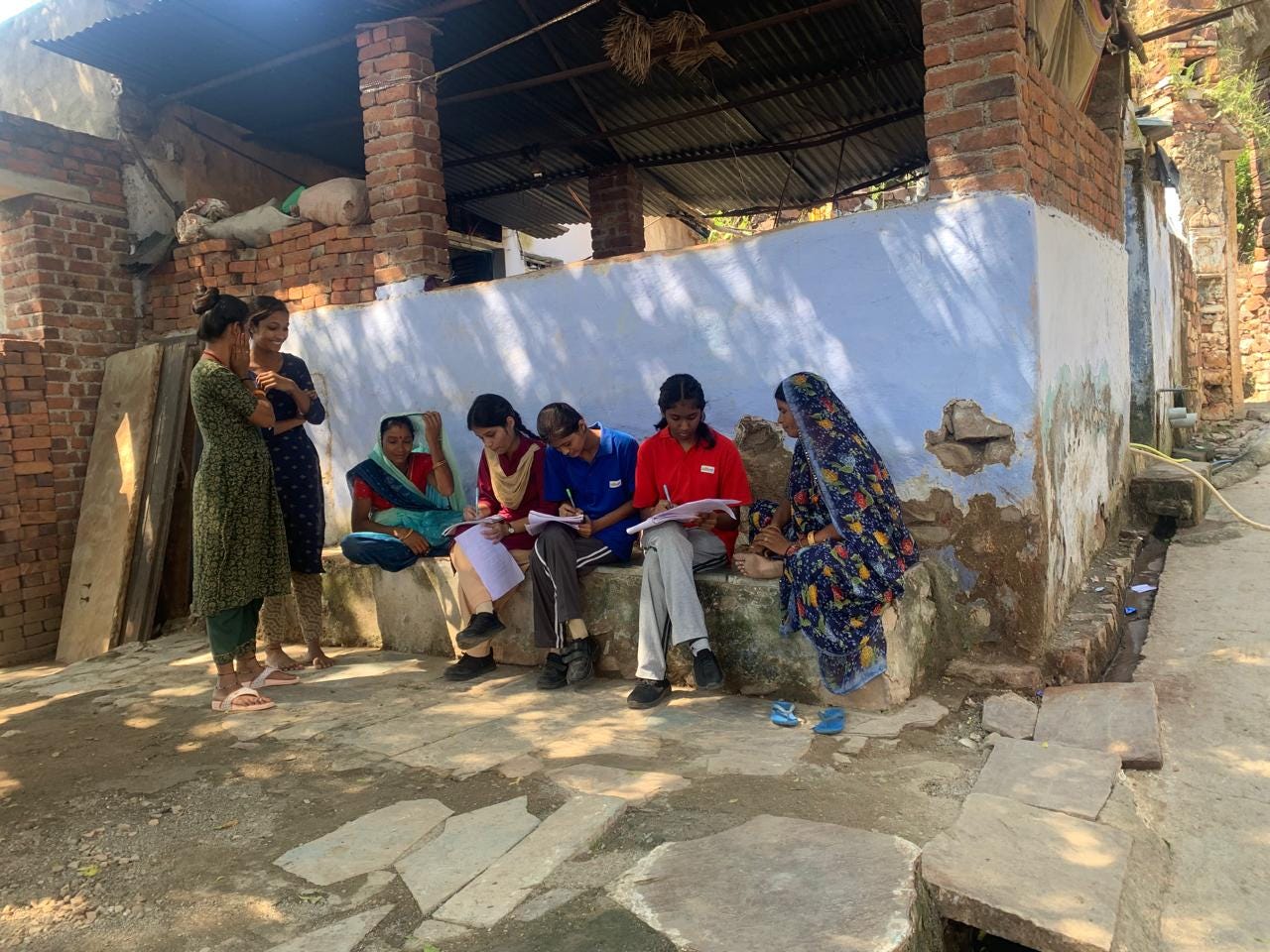Despite notable progress in female literacy, the gender gap in education remains a significant concern. As of 2022, only 70.3% of women in India were literate, highlighting systemic challenges that hinder their educational attainment, especially in rural areas. These challenges include the lack of proper schools in the catchment area of girls, deeply ingrained societal norms that deprioritise female education, and economic constraints that lead families to prioritise boys' education. Although initiatives like Beti Bachao, Beti Padhao have increased awareness and access, the projected female literacy rate of 73–75% by 2025 underscores the need for sustained, focused efforts to ensure equitable educational access and outcomes.
The issue extends beyond basic literacy to higher education. As per the 2011 Census of India, the percentage of men and women aged 20 years or above with educational qualifications of graduate level or above is 6.5% for females and 12.4% for males. This data reflects the educational attainment of individuals eligible for higher education based on age, further highlighting the gender disparity in access to and completion of higher education. Barriers such as the limited availability of higher education institutions in rural areas, early marriage, and financial dependencies deter women from pursuing advanced studies. The situation is further compounded by the declining women's workforce participation rate, which was 26.5% in 2021 compared to 54.4% for males. This trend reflects not only a lack of opportunities but also entrenched social and cultural attitudes that restrict women's economic engagement. To address these challenges, a comprehensive approach to education is essential for women in India.
This issue becomes particularly serious in light of the government implementing the RTE Act from April 1, 2010, mandating that every Indian must receive elementary education and requiring private schools to reserve 25 per cent of their seats for the underprivileged category. However, my experience of working with both government and private schools reveals a different reality. In rural areas, families often send their sons to private schools while enrolling their daughters in government schools, as they are unwilling to invest much in girls' education. This bias significantly hampers the prospects of higher education for girls.
On closer inspection, especially from ground-level observations in Rajasthan—a state known for its gender-conservative attitudes—another significant barrier emerges: safety concerns. With more than 20 years of experience working in Rajasthan and engaging with students either for research purposes or teaching, I have observed that many girls cannot attend higher secondary schools or colleges because such institutions are located far from their villages, raising fears of harassment during commutes. Even in urban areas, many educated families hesitate to send their daughters to distant universities, concerned about their safety and the potential for them to adopt behaviours perceived as undesirable. Having taught Class 12 students for more than 10 years, I often ask my female students about their aspirations for higher education. Many capable students express a preference for institutions in nearby cities where they have relatives, unlike their male counterparts who are often encouraged to pursue opportunities across the nation.
Another challenging scenario is quite peculiar. I facilitated a research project on gender education in rural areas of Jhalawar through the Humanities students of Classes 11 and 12 of Pallavan School. While the findings may not be entirely novel, what astonished the students was the revelation that many parents are reluctant to allow their daughters to pursue higher education. Their reasoning is that it would complicate the search for a suitable groom for educated girls. This mindset is not confined to economically disadvantaged families; even those who are financially well-off hold similar beliefs. They argue that, within their samaj (referring to caste), boys are typically not highly educated and are often engaged in business activities, making it challenging for them to match with wives who are more academically accomplished. This deeply entrenched perception significantly impedes the prospects of higher education for girls. Informal research indicates a similar narrative in urban Jhalawar, where such thinking prevails.
Despite these challenges, small but significant efforts can yield positive results. I have been teaching Class 11 and 12 students in Pallavan School, and when I ask the girls, they are unsure if they will fight for CUET and join a central university after pursuing Class 12. However, I have convinced several parents to allow their daughters to enrol in central universities or pursue higher education in distant cities. While these efforts are limited to only a few families each year, they demonstrate that change is possible, albeit gradual. Such initiatives, although small, contribute to a broader movement toward empowering women through education and addressing the deep-rooted barriers that hold them back.
This raises important questions: Are parents' concerns unfounded? Is the government failing to provide adequate security for girls? Renowned figures like Barack Obama, Will Smith, and India's former President Ram Nath Kovind have all acknowledged the universal concern for the safety of girls. Obama expressed the desire for his daughters to be safe and treated with respect, while Smith recognised the terrifying reality of a dangerous world. Kovind too, in his address, stressed the responsibility of creating a safe, empowered environment for women. If the most powerful people in the world are concerned for their daughters' safety, how can a common man not be concerned? Even I have a daughter studying in Class 11, and when she becomes a bit late in the evening, I start feeling uneasy. This is not because I do not trust her, but because I do not trust society.
These concerns reflect the reality that, despite the existence of strict laws and legal provisions against harassment, molestation, eve-teasing, and even rape, such incidents continue to increase. Where does the fault lie? The issue arises from the nature of these incidents—often occurring in isolated places. It is not feasible for the government to station security personnel everywhere. Therefore, the solution, I believe, lies in the upbringing of future generations. Teaching gender equality and raising awareness about gender-based discrimination and violence from the earliest stages of education is crucial. By instilling such values from playgroup or nursery, we can work toward a society where girls and parents feel secure enough to send their daughters for higher education, thus narrowing the gender gap in education and employment.
Furthermore, even when women do receive education, many are forced to abandon their careers after marriage, relegated to the roles of caregivers for their in-laws and children. While these roles are valuable and deserving of respect, it is critical to recognise that not every woman needs an advanced degree like an IIT or a PhD to manage a household. When a woman has the qualifications to contribute professionally, why should she be expected to sacrifice her potential for family duties alone? When I ask my 11th and 12th-grade female students if they are sure about working after their education, very few are confident. The response often reflects that it depends on their future in-laws or husbands. This reflects a larger issue. Many times, while discussing gender issues, I say in class, "India cannot compete with developed countries like Western Europe or the US." The students often look at me with surprise and dislike, questioning why I undermine India's ability to compete with such countries. My response is simple: How can a country compete with those where women work shoulder to shoulder with men and where their careers do not depend on their in-laws? How can India compete if its most capable and educated women are unsure of their possibility of working despite being highly deserving?
Then again, the question arises: Are Indian women not good decision-makers? Are they lacking the capability to make informed decisions? No, Indian women are not less capable than their counterparts anywhere in the world, but their upbringing and the present societal structure and norms limit their ability to think, limit their ability to get information, and limit their ability to make decisions. Why is there such a significant difference in the confidence level and decision-making ability of women born and brought up in different environments—one in the most privileged family and the other in a gender-biased, patriarchal setting? This all depends on upbringing too.
The solution, once again, lies in education. It is the most powerful catalyst for change. Education is not merely about imparting knowledge; it is a transformative tool that has the potential to reshape societal attitudes and dismantle long-standing gender biases. By educating both men and women about the importance of gender equality, we can challenge deep-rooted patriarchal norms that restrict women's roles and opportunities. An educated woman is not only better equipped to make informed decisions about her own life but also influences her family and community, creating a ripple effect of empowerment. Education fosters confidence, critical thinking, and a sense of agency, enabling women to envision and achieve their aspirations, irrespective of societal expectations. Simultaneously, educating men about the value of women's contributions—both within the family and in professional spheres—can help in cultivating a culture of respect and equality. By addressing these disparities through a well-rounded, gender-sensitive curriculum and ensuring access to quality education at all levels, we can empower women to break free from restrictive societal norms and truly contribute to the progress of the nation. Only then can we achieve true equality in education, employment, and society at large.
Many people frequently talk about women empowerment, and it is indeed true that women, particularly those who have been deprived since childhood, need empowerment. These are the women who have not had access to basic life chances such as education or essential social resources, including economic capital, social capital, and cultural capital. Empowering these women is critical, and it is the role and responsibility of not only the governments but of the whole society to support them in every possible way, helping them to reach the same level as their male counterparts in society.
However, my question is: Do young generation girls require empowerment in the same way? Do they need additional support or helping hands to prove themselves? My answer is no. While they do need certain things, such as "opportunity" and a "safe environment," these are the key factors that will enable them to thrive. If we can provide them with these two essentials, we can then see the full potential of what women can achieve.
References:
1. National Family Health Survey (NFHS-5) and National Statistical Office: NSO (2021 and 2022).
2. https://mospi.gov.in/sites/default/files/publication_reports/women-men22/EducationStatistics22.pdf
3. https://censusindia.gov.in/census.website/data/census-tables
4. https://censusindia.gov.in/nada/index.php/catalog/45261
5. https://www.etonline.com/barack-obama-opens-up-about-his-daughters-activism-and-admits-he-worries-about-their-safety-167048







Excellent thought regarding women empowerment, 👍 well done.
Thoughtful topic and excellently written.
Women empowerment has always been a task which have not been fully achieved yet. Anything comes from our mind may be our thoughts, actions, etc and empowerment or disempower women comes from mind only. A working woman comes from work again to work only.
It has been set by the society that certain jobs our the jobs of women only. Women's are considered as machines.